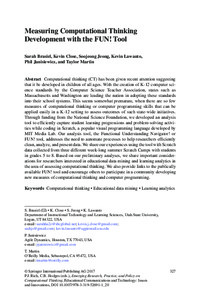Measuring Computational Thinking Development with the FUN! ToolSarah Brasiel, Kevin Close, Soojeong Jeong, Kevin Lawanto, Phil Janisiewicz
Zu finden in: Emerging Research, Practice, and Policy on Computational Thinking (Seite 327 bis 347), 2017
  |
 |
 Diese Seite wurde seit 6 Jahren inhaltlich nicht mehr aktualisiert. Unter Umständen ist sie nicht mehr aktuell.
Diese Seite wurde seit 6 Jahren inhaltlich nicht mehr aktualisiert. Unter Umständen ist sie nicht mehr aktuell. Zusammenfassungen
Zusammenfassungen

Computational thinking (CT) has been given recent attention suggesting that it be developed in children of all ages. With the creation of K-12 computer science standards by the Computer Science Teacher Association, states such as Massachusetts and Washington are leading the nation in adopting these standards into their school systems. This seems somewhat premature, when there are so few measures of computational thinking or computer programming skills that can be applied easily in a K-12 setting to assess outcomes of such state-wide initiatives. Through funding from the National Science Foundation, we developed an analysis tool to efficiently capture student learning progressions and problem-solving activities while coding in Scratch, a popular visual programming language developed by MIT Media Lab. Our analysis tool, the Functional Understanding Navigator! or FUN! tool, addresses the need to automate processes to help researchers efficiently clean, analyze, and present data. We share our experiences using the tool with Scratch data collected from three different week-long summer Scratch Camps with students in grades 5 to 8. Based on our preliminary analyses, we share important considerations for researchers interested in educational data mining and learning analytics in the area of assessing computational thinking. We also provide links to the publically available FUN! tool and encourage others to participate in a community developing new measures of computational thinking and computer programming.
 Dieses Kapitel erwähnt ...
Dieses Kapitel erwähnt ...
 Personen KB IB clear | Karen Brennan, Evelyn Eastmond, Yasmin B. Kafai, Caitlin Kelleher, John Maloney, Amon Millner, Andrés Monroy-Hernández, Randy Pausch, Mitchel Resnick, Eric Rosenbaum, Natalie Rusk, Jay Silver, Brian Silverman, Jeannette M. Wing | ||||||||||||||||||||||||||||||||||||
 Fragen KB IB clear | Wie lassen sich Computerprogramme bewerten/benoten? | ||||||||||||||||||||||||||||||||||||
 Begriffe KB IB clear | computational thinkingcomputational thinking,  Programmieren Programmieren programming programming | ||||||||||||||||||||||||||||||||||||
 Texte |
|
 Zitationsgraph
Zitationsgraph
 Anderswo finden
Anderswo finden
 Volltext dieses Dokuments
Volltext dieses Dokuments
 |  Measuring Computational Thinking Development with the FUN! Tool: Artikel als Volltext bei Springerlink ( Measuring Computational Thinking Development with the FUN! Tool: Artikel als Volltext bei Springerlink ( : :  , 673 kByte; , 673 kByte;  : :  ) ) |
 Anderswo suchen
Anderswo suchen 
 Beat und dieses Kapitel
Beat und dieses Kapitel
Beat hat Dieses Kapitel während seiner Zeit am Institut für Medien und Schule (IMS) ins Biblionetz aufgenommen. Er hat Dieses Kapitel einmalig erfasst und bisher nicht mehr bearbeitet. Beat besitzt kein physisches, aber ein digitales Exemplar. Eine digitale Version ist auf dem Internet verfügbar (s.o.). Aufgrund der wenigen Einträge im Biblionetz scheint er es nicht wirklich gelesen zu haben. Es gibt bisher auch nur wenige Objekte im Biblionetz, die dieses Werk zitieren.











 Biblionetz-History
Biblionetz-History